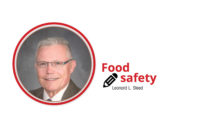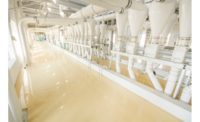Food safety is the single most important aspect of food production, requiring management commitment, proper resources, effective training, employee dedication, and follow up. All food safety systems are living and breathing. They will be ever changing, needing to be updated and revised as needed when new systems come on line or challenges arise.
Flour mills are wonderful producers of food. They are highly automated while producing large volumes of product with enclosed systems that transfer the wheat from different sections of the plant through piping and the use of the various processing machines. It is a very efficient process.
However, they do present a challenge. First is the nature of cleaning the facility. Water cannot be used as in most food plants where they spray down equipment and use sanitizers. One reason for the lack of water use is that some of the mills have wood used throughout their plants. Another reason is that water upon touching flour will create an untidy sanitation problem itself. Thus all cleaning must be dry form using brooms and brushes using a predetermined SSOP.
Another challenge at the flour mills is personnel. While it may be a great value for the company owning the flour mill to be able to use as few people as possible, it is a hardship with regards to food safety. Getting facilities certified for GFSI schemes and meeting other food safety standards requires thorough training of the employees. Additionally, responsible individuals will need to be assigned for all tasks related to food safety. While all employees receive basic food safety training, specific persons are given training above and beyond related to their responsibilities.
Developing a Hazard Analysis and Critical Control Points (HACCP) plan for four mills requires a unique understanding of the biological, chemical and physical hazards specific to this environment. Remember HACCP starts with planning, prevention and training and is executed right on the plant floor. Keep these and all potential hazards in mind so that your HACCP program is unique and sound for your facility.
Biological:
Flour mills produce is a “Ready to Cook” product, meaning it has to be processed by cooking prior to consumption. An advantage of an RTC product over a “Ready to Eat” product is any potential microbiological contamination it should be eliminated while cooking either at the bakery or in the consumer’s home. Deoxynivalenol, commonly known as Vomitoxin is an example. Produced by several mold species of the genus Fusarium, vomitoxin is naturally occurring in wheat depending on moisture, less in dry growing years but present in wet. FDA has a guideline of 1 ppm on finished flour, stating that Deoxynivalenol is not completely avoidable in wheat but levels can be reduced in the milling process. Control measures at receiving (testing) help to reduce or eliminate this hazard to an acceptable level. Loads of wheat are rejected if they test above set levels for Vomitoxin.
Salmonella from wheat has also been linked to food safety outbreaks in flour. Studies have shown the rate of wheat flours containing Salmonella can be as great as 1.3 percent. Salmonella poses a significant food safety hazard in raw flour, however if baked at 375° F. for 17 minutes or more Salmonella and any other pathogen will be destroyed.
The findings of toxic seeds in incoming ingredients or raw materials in the United States is infrequent Although some geographic areas such as Australia have the potential risk of contamination, toxic seeds are not evidenced in areas where in the major grain growing areas in the USA. Therefore, toxic seeds have been determined to not be a significant hazard.
Chemical hazards:
There are few chemical hazards used in a RTC facility and those that are can be safely stored to prevent a contamination hazard. Otherwise, for incoming product, be aware of the potential for higher than acceptable levels per EPA/FDA guidelines of Fungicides, Pesticides and Insecticides on incoming wheat.
These are applied by farmers to their crops and storage bins in order to control Vomitoxin, mold, pests and insects. If these chemical hazards are not controlled at wheat receiving, there is a potential for contamination. Therefore Fungicides, Pesticides and Insecticides are deemed a significant food safety hazard.
Soybeans should also be considered a significant food safety hazard as due to crop rotations there is the potential for cross contamination of soy protein in incoming wheat.
Grease and oil used as lubricants for moving parts on mill equipment should also be considered a food safety hazard. There is a potential that food grade grease or oil may contaminate products in absence of control measures taken such as preventative maintenance, equipment monitoring and proper storage of chemicals.
Physical hazards:
The most severe types of food safety hazards at flour mills are physical in nature and include various forms of metal, bugs, wood and others too numerous to mention. Wheat plants commonly find foreign material in raw incoming wheat. Farmers pick up glass, metal, stones, tools, wood and other items during the harvest process and in the absence of control measures at receiving (inspection), preventative maintenance, metal detection, magnets, sifters and equipment monitoring there is potential for foreign material contamination. Foreign material therefore can be considered a significant food safety hazard.
Physical hazard prevention begins in receiving when what is inspected at the time of unloading. At this point the receiving person can prevent any visible items from entering the food chain. One flour mill that I inspected found a toolbox upon unloading!
After the wheat proceeds into the mill, Scourers, Roll Stands, Sifters, Magnets and Metal Detectors to help identify and eliminate any physical hazards in the flour. All of these machines should perform a work instruction and physical inspection on each delivery vehicle that brings wheat to the mill. The wheat should be probed and tested for moisture. The mill will perform a Don / Vomitoxin test on loads. All information shall be filled out on Incoming Material Receiving Form. All of this equipment should be regularly monitored and on preventative maintenance schedule.
Scourers
Flour mills use scourers for cleaning wheat. The scourers efficiently remove impurities such as dust, sand, mold, clods of soil and any other non-wheat material that adhere to the grain, thus providing ideal preparation for grinding. The scourer significantly improves product hygiene – by reducing the microbial count (bacteria, fungus etc.) as well as minimizing the presence of insects or their fragments.
Roll stands
A Roll stand is a double roller mill that does particle size reduction through a combination of forces and design features. They are energy efficient, create little noise and dust generation, and have uniform particle-size distribution. They are able to be opened during production (following intrusive work instruction) to inspect and determine if they are operating properly.
Magnets
Magnets help to keep the product and equipment free from metal fines and tramp metals. They are used to remove metal particles from the wheat and/or flour going through the process. Magnets are monitored and checked using work instruction.
Enclosed System
An enclosed processing system in a flour mill means the wheat and/or flour is transferred by a series of pipes from roll stands to airlocks to cyclones to sifters throughout the mill until it either goes into storage or is packed into bags or totes, or is loaded into bulk trailers. The process is typically very safe.
Sifters
Most mills have many sifter sections. The sifters remove oversize or foreign materials and de-dusts the material to meet final product specs. The sifter controls both oversized and undersized material. They utilize a sieve to effect particle size separation through the use of finely meshed bolting cloths. They are used for grading grains as per length, width size, immature grain, broken sizes. The mills should use a work instruction in regard to cleaning and inspecting sifters.
Metal detector
Mills will utilize metal detector (s) throughout the process. These are typically set for detecting 2.0mm stainless steel in 50-100 lb. bags of dry product. The system also will detect ferrous and non-ferrous metal as small as 1.5 mm. Metal detection in a bagging area can be a Control Point or Critical Control Point at the mill’s discretion. The mill should use a work instruction in regard to the metal detector operation.
Pest control:
PEST CONTROL is capitalized as it is of critical importance at flour mills. Many pests including rats, mice, birds and others are commonly found in and around flour mills. Companies must have a vibrant and effective pest control program to protect their food products from being contaminated. They must have a good pest control company and PCO (Pest Control Operator). The pest control firm should have sufficient traps inside at adequate spacing, on each side of all man and dock exit doors that are checked weekly. Outside perimeters must have bait stations spaced appropriately and monitored at least monthly. Additionally, all PCO’s should have liability insurance, applicator licenses and training certificates. They must have maps of the locations of all traps and bait stations, sighting logs, service reports, SDS and chemical usage form.




